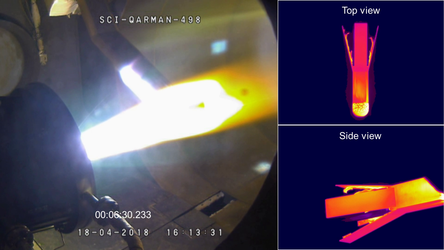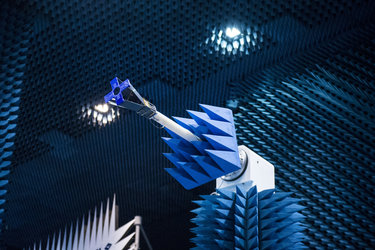Accept all cookies Accept only essential cookies See our Cookie Notice

About ESA
The European Space Agency (ESA) is Europe’s gateway to space. Its mission is to shape the development of Europe’s space capability and ensure that investment in space continues to deliver benefits to the citizens of Europe and the world.
Highlights
ESA - United space in Europe
This is ESA ESA facts Member States & Cooperating States Funding Director General Top management For Member State Delegations European vision European Space Policy ESA & EU Space Councils Responsibility & Sustainability Annual Report Calendar of meetings Corporate newsEstablishments & sites
ESA Headquarters ESA ESTEC ESA ESOC ESA ESRIN ESA EAC ESA ESAC Europe's Spaceport ESA ESEC ESA ECSAT Brussels Office Washington OfficeWorking with ESA
Business with ESA ESA Commercialisation Gateway Law at ESA Careers Cyber resilience at ESA IT at ESA Newsroom Partnerships Merchandising Licence Education Open Space Innovation Platform Integrity and Reporting Administrative Tribunal Health and SafetyMore about ESA
History ESA Historical Archives Exhibitions Publications Art & Culture ESA Merchandise Kids Diversity ESA Brand Centre ESA ChampionsLatest
Space in Member States
Find out more about space activities in our 23 Member States, and understand how ESA works together with their national agencies, institutions and organisations.
Science & Exploration
Exploring our Solar System and unlocking the secrets of the Universe
Go to topicAstronauts
Missions
Juice Euclid Webb Solar Orbiter BepiColombo Gaia ExoMars Cheops Exoplanet missions More missionsActivities
International Space Station Orion service module Gateway Concordia Caves & Pangaea BenefitsLatest
Space Safety
Protecting life and infrastructure on Earth and in orbit
Go to topicAsteroids
Asteroids and Planetary Defence Asteroid danger explained Flyeye telescope: asteroid detection Hera mission: asteroid deflection Near-Earth Object Coordination CentreSpace junk
About space debris Space debris by the numbers Space Environment Report In space refuelling, refurbishing and removingSafety from space
Clean Space ecodesign Zero Debris Technologies Space for Earth Supporting Sustainable DevelopmentApplications
Using space to benefit citizens and meet future challenges on Earth
Go to topicObserving the Earth
Observing the Earth Future EO Copernicus Meteorology Space for our climate Satellite missionsCommercialisation
ESA Commercialisation Gateway Open Space Innovation Platform Business Incubation ESA Space SolutionsLatest
Enabling & Support
Making space accessible and developing the technologies for the future
Go to topicBuilding missions
Space Engineering and Technology Test centre Laboratories Concurrent Design Facility Preparing for the future Shaping the Future Discovery and Preparation Advanced Concepts TeamSpace transportation
Space Transportation Ariane Vega Space Rider Future space transportation Boost! Europe's Spaceport Launches from Europe's Spaceport from 2012Latest

Reentry test of QARMAN CubeSat
Thank you for liking
You have already liked this page, you can only like it once!
ESA’s next CubeSat mission seen enduring the scorching heat of simulated atmospheric reentry inside the world’s largest plasma wind tunnel.
Equipped with a cork-based heatshield, titanium side walls and silicon carbide deployable panels, the QARMAN (QubeSat for Aerothermodynamic Research and Measurements on Ablation) CubeSat survived six and a half minutes of testing inside Italy’s Scirocco Plasma Wind Tunnel.
An arc jet using up to 70 megawatts of power – enough to light up a town of 80 000 people – converted air into hot plasma at temperatures of several thousand degrees Celsius, which sped towards QARMAN at seven times the speed of sound. See video of the test here.
“This test marked the world premiere in arc jet testing of a complete, full-scale spacecraft,” explains test engineering group leader Eduardo Trifoni. “It also represents a tremendous step forward in our ground testing, since up to now only single components were tested at a time.”
CubeSats are low-cost nanosatellites based around standard 10 cm units and typically end their spaceflights burning up in the atmosphere as their orbits gradually decay. But the three-unit QARMAN is designed with this fiery fate in mind.
Designed and manufactured for ESA by Belgium’s Von Karman Institute, QARMAN will use temperature and pressure sensors together with an emission spectrometer to gather precious data on the extreme conditions of reentry as its leading edges are enveloped in scorching plasma.
“The precious outcome of this test gives us confidence that the QARMAN design will indeed make it through the reentry phase,” said project leader Davide Masutti of the Von Karman Institute. “The results of the real flight are now the missing element to consolidate our design strategy based on ground-testing, numerical models and flight data.”
QARMAN is due to be deployed from the International Space Station next year. It will orbit Earth for around four months before reentering the atmosphere. It will survive reentry but not its fall to Earth. Instead its data will be transmitted to Iridium telecom satellites.
-
CREDIT
CIRA -
LICENCE
ESA Standard Licence

Qarman CubeSat - infographic

Reentry CubeSat’s plasma wind tunnel testing

Qarman CubeSat in Hertz test chamber

Qarman reentry CubeSat















 Germany
Germany
 Austria
Austria
 Belgium
Belgium
 Denmark
Denmark
 Spain
Spain
 Estonia
Estonia
 Finland
Finland
 France
France
 Greece
Greece
 Hungary
Hungary
 Ireland
Ireland
 Italy
Italy
 Luxembourg
Luxembourg
 Norway
Norway
 The Netherlands
The Netherlands
 Poland
Poland
 Portugal
Portugal
 Czechia
Czechia
 Romania
Romania
 United Kingdom
United Kingdom
 Slovenia
Slovenia
 Sweden
Sweden
 Switzerland
Switzerland

























